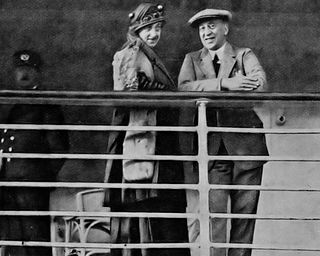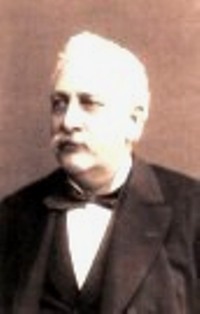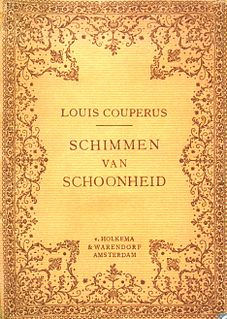Related Research Articles

Alexander Louis Teixeira de Mattos , known as Alexander Teixeira de Mattos, was a Dutch-English journalist, literary critic and publisher, who gained his greatest fame as a translator.

Louis Marie-Anne Couperus was a Dutch novelist and poet. His oeuvre contains a wide variety of genres: lyric poetry, psychological and historical novels, novellas, short stories, fairy tales, feuilletons and sketches. Couperus is considered to be one of the foremost figures in Dutch literature. In 1923, he was awarded the Tollensprijs.
Lefebvre is a common northern French surname. Other variations include Lefèbvre, Lefèvre, Lefeuvre and Lefébure.
Kuiper is a Dutch occupational surname meaning cooper. Common spelling variants include Kuyper, Kuipers, Kuijper, Kuijpers, Kuypers, and De Kuyper. Notable people with the name include:

Donald James Mackay, 11th Lord Reay was a Dutch-born British administrator and Liberal politician.
Kuipers is a Dutch occupational surname meaning cooper's. Common spelling variants include Kuiper, Kuijpers, and Kuypers. Notable people with the surname include:
Kuijpers or Kuypers is a Dutch surname corresponding to the English Cooper. Variant spellings are Kuipers, Kuiper, and Cuypers.
Visscher is a Dutch occupational surname. Visscher is an archaic spelling of Dutch visser meaning "fisherman". Varianta are Visschers and De Visscher. The latter form is now most common in East Flanders. Notable people with the surname include:
Van Vliet is a toponymic surname of Dutch origin. The original bearer may have lived or worked near a vliet, a Dutch term for a minor stream. The name is quite common in the Netherlands, ranking 40th in 2007. Variations include Van de Vliet and Van der Vliet. People with this surname include:
De Laet is a Dutch-language occupational surname. A "laet" was a type of (released) serf. The archaic spelling De Laet is most common in Belgium, especially around Antwerp, while "de Laat" is more common in the Netherlands, especially in North Brabant. People with this name include:
Clara Bell, née Poynter (1835–1927), was an English translator fluent in French, German, Danish, Dutch, Italian, Norwegian, Russian, and Spanish, noted for her translations of works by Henrik Ibsen, Balzac, Georg Ebers, Huysmans, Maupassant, Pérez Galdós and others. She was educated in France, where she became fluent in French and German; she did not acquire her knowledge of the other languages until after her fortieth birthday. She spent most of her life in London.

Eline Vere is an 1889 novel by the Dutch writer Louis Couperus. It was adapted into the 1991 film Eline Vere, directed by Harry Kümel. Couperus wrote Eline Vere in the house at Surinamestraat 20, The Hague.
Caroline Anne Freiin de Westenholz is a Dutch art historian. She is the founder of the Louis Couperus Museum in The Hague.

Elisabeth Wilhelmina Johanna (Betty) Couperus-Baud, was a Dutch translator. She was the wife of the Dutch writer Louis Couperus (1863–1923).

John Ricus Couperus was a Dutch lawyer, member of the Council of Justice in Padang and member of the High Military Court of the Dutch East Indies. He was also the father of the Dutch writer Louis Couperus and knight in the Order of the Netherlands Lion.

Schimmen van schoonheid is a collection of short stories, written by Louis Couperus and published by Van Holkema & Warendorf in 1912. It is not known how many copies were printed for the first edition, but this edition was in any case sold out by 1929. The second edition was published in 1962 by Querido in the so-called Salamander series.
Rademaker is a Dutch occupational surname originally meaning wheelwright or wainwright. A large number of spelling variations are seen, the most common of which are : Raaijmakers (4086), Raaymakers (301), Rademaker (3094), Rademakers (2037), Raemaekers (939), Raeymaekers (2112), Raijmakers (1398), Ramaekers (3244), Ramaker (2122), Ramakers (2058), and Raymakers (504). People with these surnames include:

Bastiaan Johan "Bas" Heijne is a Dutch writer and translator.
Harmen is a Dutch variation of the masculine given name Herman. A common short form is Harm. People with the name include:
Luyckx is a Dutch patronymic surname based on an archaic spelling of the given name Luuk/Luc, short forms of Lucas. The name has a myriad of spellings, each pronounced [lœy̯k(s)]. While in Belgium Luyckx is by far the most common, in the Netherlands the forms Luijkx, Luijks, Luijk, Luik and Luijckx are more prevalent. For some families the name may be toponymic instead, referring to an origin in Luik, the Dutch name of Liège. This is generally the case for forms like Van Luijk, Van Luik and de Luyck. People with these surnames include:
References
| This page lists people with the surname Kuperus. If an internal link intending to refer to a specific person led you to this page, you may wish to change that link by adding the person's given name(s) to the link. |